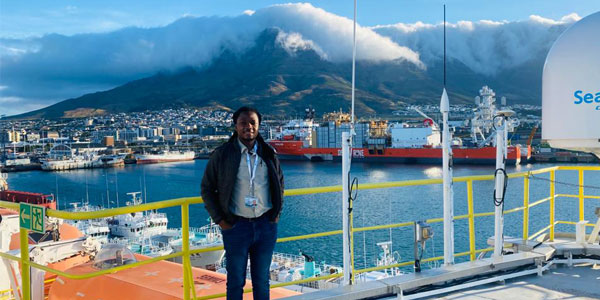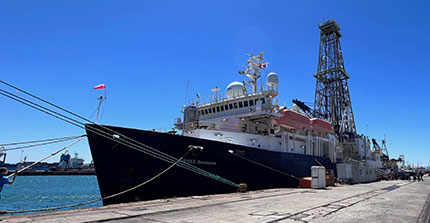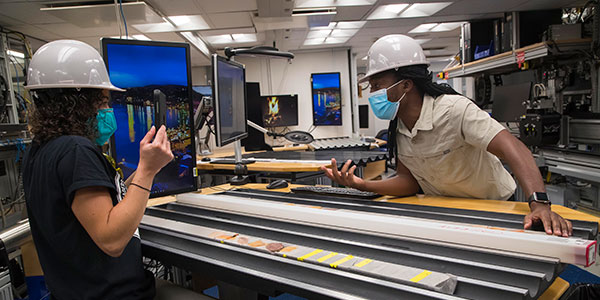Wits audience get a virtual tour of the JOIDES Resolution research ship
- Wits Communications
Virtual linkup was done live from the ship while the ship was on an expedition to conduct science operations on the Walvis Ridge, off the coast of Namibia.
A Wits audience got a special tour of the JOIDES Resolution research ship as the ship was conducting science operations on the Walvis Ridge, off the coast of Namibia in February.
Arranged by Professor Susan Webb, from the Wits School of Geosciences, the audience was treated by a virtual guided tour of the ship, including the Bridge and the laboratories. The tour was partly led by Dr Mbili Tshiningayamwe, who completed his PhD in Geology at Wits in 2021.

The JOIDES Resolution is a 143 metres long ocean-drilling research vessel that drills into the ocean floor to collect and study core samples. Scientists use data from the JOIDES Resolution to better understand climate change, geology and Earth’s history. It is a part of the International Ocean Discovery Programme and is funded by the US National Science Foundation.
The ship undertook a 62 day expedition from 6 December 2021 to 5 February 2022 to the Tristan-Gaugh hotspot track (Walvis Ridge), which is said to be one of the most complicated hotspot tracks on Earth, in an attempt to understand why volcanoes occur in certain places, and how they affect Earth’s crust.
The Walvis Ridge is a large mountain under the ocean’s surface, created by active, ongoing activity. In geology, hotspots are volcanic locales thought to be fed by underlying mantle that is anomalously hot compared with the surrounding mantle.
Webb arranged the virtual ship visit after seeing a picture of the ship in Cape Town harbour on Twitter.
“I’ve always wanted to join one of these expeditions, and when I saw a tweet from the ship with Table Mountain in the background I immediately tweeted back and asked whether there are South African scientists on board,” says Webb.
 The response came immediately, saying that there were no South African scientists on board. However, there were two Namibians, including Dr Tshiningayamwe, the Wits Alumni, who got a spot on the ship through answering a call for applications in an advertisement.
The response came immediately, saying that there were no South African scientists on board. However, there were two Namibians, including Dr Tshiningayamwe, the Wits Alumni, who got a spot on the ship through answering a call for applications in an advertisement.
“The advertisement to participate in the Joides Resolution, expedition 391 project was forwarded to us, the Geology department of the University of Namibia (UNAM) by the head of department and it was from the JOIDES Resolution expedition project manager. I applied by submitting the requested documents and that is a letter of interest as well as my CV,” says Tshiningayamwe.
Tshiningayamwe sailed as an igneous petrologist. His duties included describing igneous rocks and analysing their chemical compositions using a portable x-ray machine. He also had to take images of rocks and measure the magnetic susceptibility and the colour reflectance of drilled rocks.
“What attracted me to the project was because it was about drilling the Walvis Ridge volcano located in the south of Atlantic Ocean, in order to test hypothesis of mantle plume zonation, hotspot drift and the formation of the Walvis ridge using geochemistry, geochronology and paleomagnetic measurements,” says Tshiningayamwe.
“Mantle plume is a large column of hot material rising from deep within the earth s structure which can result in volcanic eruptions when it reaches the earth’s surface.”
The virtual tour of the ship was especially arranged for the Wits Community on February 3, and while several of these tours are hosted at schools around South Africa, Webb asked for a more focussed talk on the science and the labs aboard the ship.
“It was especially impressive to see how tough the drilling process is as they have to drill down to 4km below the ocean surface, while holding the ship completely steady,” says Webb.

“It was also impressive to see the facilities on board the ship. The lab equipment they have on board is almost as much as we have in the Geology department.
What excited Webb the most, however, was that opportunities such as joining an expedition on board a research vessel such as this exist, and is easily attainable for South African researchers.
“The JOIDES Resolution expeditions happen every two months with each expedition having its own objectives,” says Tshiningayamwe.
“People who want to participate should visit the JOIDES Resolution, International Ocean discovery program website at iodp.tamu.edu. Information regarding the need for scientists to participate as well as expedition objectives can be found there.”
More information about the JOIDES Resolution and opportunities for talks and research can be found here: https://joidesresolution.org

